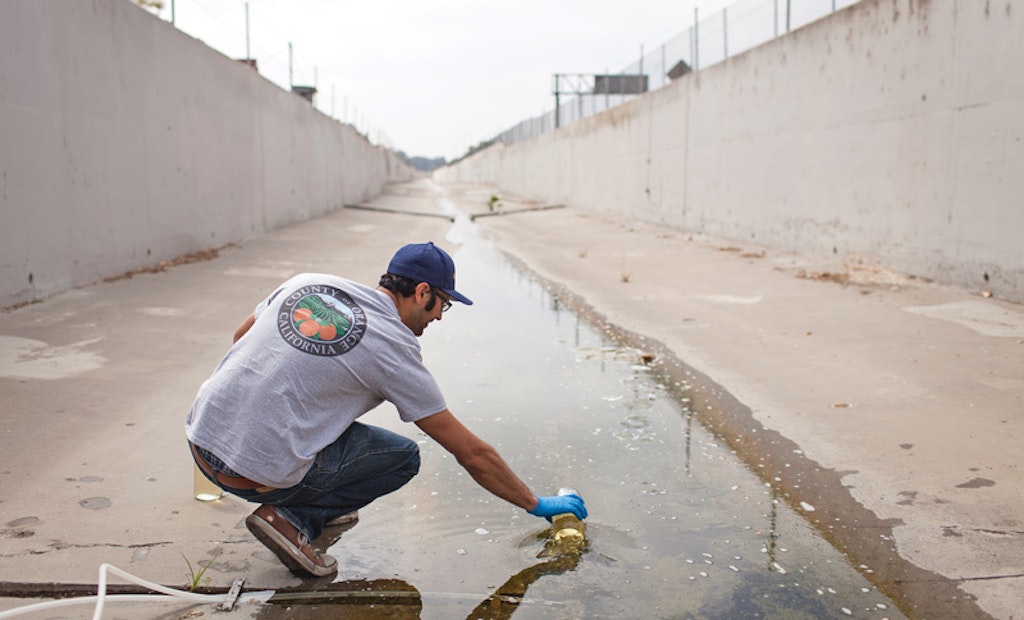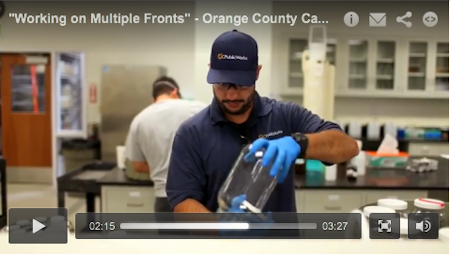
Interested in Education/Training?
Get Education/Training articles, news and videos right in your inbox! Sign up now.
Education/Training + Get AlertsWith 3.1 million residents and an annual rainfall of only about 13 inches, the Orange County (Calif.) Public Works — OC Watersheds Division understands stormwater management and public education go hand in hand when it comes to protecting local water resources.
Covering a relatively small land area of less than 1,000 square miles, the dense urban environment has a high level of imperviousness, which makes managing stormwater runoff and pollution a challenge.
Since its inception in 1990, the Orange County stormwater program has evolved considerably as data collection methods have advanced, public education needs have changed and NPDES permit requirements have strengthened.
“There are a lot of things that have changed since the beginning of the program, including expansion of the public education program, advancements in data collection, storage and analysis tools, and in particular the way land is developed or redeveloped in Orange County,” says Jenna Voss, environmental re-source specialist for OC Watersheds.
While the U.S. EPA enforces the Clean Water Act requirements nationally, California has a State Water Resources Control Board and nine associated regional water quality control boards to ensure compliance.
As a municipal separate storm sewer system (MS4), Orange County must obtain and implement NPDES permits for the Santa Ana and San Diego Regional Water Quality Control Board regions. The stormwater program elements are developed collaboratively and cooperatively through Orange County, the Orange County Flood Control District and the 34 incorporated cities. Orange County will begin working on the permit renewal process this year as the current fourth-term NPDES permits for the Santa Ana and San Diego Regions are up in May and December 2014, respectively.
Best laid plans
Orange County relies on structured and established best management practices (BMPs) to cost-effectively manage and improve the quality of stormwater runoff. The stormwater program has developed a collection of programmatic documents to focus its program.
The Drainage Area Management Plan (DAMP) establishes the groundwork for Orange County to ensure it is in compliance with permit requirements. It is the foundation for land development and redevelopment project requirements, watershed planning, regulatory oversight of the built environment for water quality protection and educational outreach and assessment. “The DAMP is the primary policy and planning and implementation document for our stormwater program,” Voss says. “Each of the key pieces of our program has a section in this primary guidance document, including construction, municipal activities and public education.”
The Model Water Quality Management Plan (WQMP) is part of the land development and redevelopment program. It sets a process based on permit requirements that contractors must follow to ensure development projects or significant redevelopment projects address stormwater runoff and pollution. “If someone has a project of a certain size or that meets certain specifications, they have to utilize this model to put together their own project WQMP to address post-construction urban runoff and stormwater pollution,” Voss says.
Although OC Watersheds staff members assist with review of project plans, each jurisdiction reviews the plans for projects within their city. “For example, if a developer comes to the county or one of the cities with a plan to expand their current facility, the jurisdiction staff will determine whether the project meets the qualifications for a significant redevelopment, which depends on requirements of the NPDES permits and includes specifications like the construction footprint, type of facility and where it is located within a watershed,” Voss says. “If the project meets the specifications of the permit, the applicant must submit a plan for how they’re going to implement BMPs to ensure that they are not causing impacts to the receiving waters.”
As NPDES permit requirements have changed in the last few years, emphasis has shifted from structural BMPs that treated the flow from the site, removed pollutants and allowed the treated flow to continue off site, to the use of low-impact development (LID) BMPs that prioritize onsite infiltration, retention and treatment.
LID BMPs fall into four categories: infiltration, evapotranspiration and evaporation, harvest and use, and biotreatment. With the fourth-term MS4 permit requiring low-impact BMPs, new land development and redevelopment projects must include things like soil amendments, vegetated swales, cisterns, infiltration basins and permeable pavement wherever feasible.
“Developers must conduct a feasibility study to prove that infiltration is not possible on the site in order to use other BMPs,” Voss says. “The Model WQMP and accompanying technical guidance document specify how BMPs should be incorporated in site design to retain pollutants on site and reduce or eliminate the flow leaving the site. If it is feasible to use LID BMPs to retain stormwater on site, it can prevent pollution from entering the system through runoff.”
Both the DAMP and the Model WQMP ensure Orange County is meeting permit requirements for its stormwater management program. The plans also educate Orange County businesses and contractors on the importance of stormwater pollution prevention. “Education itself is a source-control BMP to address and stop pollution at the source,” Voss says.
Students become teachers
The Orange County stormwater program includes a monitoring element to establish a baseline for water quality and to collect data for comparison and trending over time. Water-quality testing at locations throughout the county provides insight into the state of water resources and to identify and prioritize areas for which targeted response or modified monitoring may be required.
“Regular monitoring determines the overall integrity of the county’s water resources by assessing the biological, chemical and physical components of waterways,” Voss says. Water quality monitoring can also indicate whether there is an active illegal discharge into the system that requires follow-up action. A 24-hour pollution response hotline makes it easy for the public to report suspected spills or pollution incidents. “This has been an important tool for educating the public on activities that can lead to pollution and for responding to incidents that can have significant impacts to receiving waters.”
The stormwater program coordinates outreach through an extensive public education campaign called H2OC. Developed in 2002, H2OC includes educational materials and messaging to provide best practices for residents and businesses, and seeks to make the connection between preservation of water resources for future generations and simple day-to-day activities that residents can adopt. Outreach activities include presentations in classrooms and at local water festivals and events, creation of educational materials such as online BMP-specific brochures and development of collaborative outreach programming.
“The public education program is especially collaborative, as we have a committee comprising city representatives who review and approve all materials, messaging and outreach efforts,” Voss says. “This collaboration defines our program and is integral to what we do to prevent stormwater pollution.”
Individual cities and districts can adapt the educational materials based on their specific needs. “As the principle permittee for H2OC, we administer the countywide program, but as part of that, we work collaboratively with the cities to develop program materials,” Voss says.
In collaboration with the Discovery Science Center located in Santa Ana and the Municipal Water District of Orange County, H2OC can target a greater audience to educate residents. “We support school programs or organizations that do school outreach because we can reach more kids that way,” Voss says. The county worked with the Discovery Science Center to put together a workbook that meets the science content standards for fifth-grade curriculum. “All 11,000 fifth-graders in that program will get the workbook this year.”
The success of the county’s stormwater management program depends on continued learning and ensuring that residents pass on the information to future generations. One way to do that is by turning the students into teachers.
“I worked on behalf of H2OC with Chapman University in Orange to put together a program called the Watershed Education Ambassador Program,” Voss says. “Chapman wanted to connect their students to the issue of water and I wanted to expand our school outreach on a one-on-one basis, so we developed a program where the university students would become the teachers. As the coordinator of H2OC, I trained a group of 10 Chapman students on how to give presentations about water pollution prevention, watersheds and the water cycle using an Enviroscape watershed model.” The students-turned-teachers took the information they learned into local fifth-grade classrooms last May. “They did a really good job and it was clear that both the college and elementary students learned about pollution prevention.”
Measuring success
Similar to recording water-quality data over time through monitoring, H2OC has been able to track the success of public education program implementation for the past 10 years to document increases in stormwater awareness and willingness of residents to adopt “stormwater safe” behaviors such as sweeping a driveway instead of using a hose.
“We conduct biennial public awareness surveys that are large-scale scientific phone surveys,” Voss says. “We’ve been asking some of the same questions since the first survey in 2003 to document increases in knowledge and willingness to adopt BMPs.” A total of 1,500 registered voters are selected at random for each survey, 300 in each of the county’s five supervisorial districts.
The county pairs the data gathered from the surveys with information from other regular analyses. “The surveys give us an indication of knowledge and behavior,” Voss says. “Over time we’ve seen incremental but statistically significant increases in knowledge and changes in behavior. There is year-to-year variation, but it has been encouraging because it seems like there’s an overall increase in knowledge. We’ve noticed that the changes in behavior are really long term.”
Smaller focused phone surveys offer an opportunity for Orange County to pinpoint specific groups or targeted behaviors on which to focus its outreach efforts. “The goal is to see if there is a specific group of people who would be perfect to outreach to,” Voss says. “It helps us identify our target audiences. We want to be able to see on a more localized level that change is taking place.”
One of the targeted behaviors the county is focusing on based on a smaller survey is overwatering. “Several of those participants have said they were willing to provide us more information about their watering habits over a longer period,” Voss says. “We want to be able to track them individually to see changes in behavior.”
Structurally sound
While educating the public on stormwater pollution prevention is vital, managing stormwater runoff and implementing infrastructure for new land development and redevelopment is equally important — even with just 13 inch es of annual rainfall.
And it’s evident from recent statistics that people are embracing new low-impact development systems. From 2011 to 2012, 9,500 acres of land development projects implemented low-impact BMPs throughout the county.
A housing development along the Santa Ana River in Orange County uses a large vegetated swale to intercept runoff from adjacent streets for infiltration. By incorporating practices such as swales, developments like this lessen the impacts of impervious area added through new development and significant redevelopment projects as defined by the Model WQMP.
Another example of stormwater management through the use of low-impact development is located in Mission Viejo. A vegetated swale engineered to simulate a dry creek bed the majority of the year accepts runoff during the wet season from the parking lot adjacent to the city’s Norman P. Murray Community Center. Rock and plant features in the swale slow water runoff and encourage infiltration on site, thereby treating parking lot runoff and preventing pollution from reaching nearby Oso Creek during small storm events.
The county’s overall stormwater management program has matured since its inception, and with a team of 30, the OC Watersheds department has been very successful in achieving its goals.
“We divide and conquer,” Voss says. “The only way we can really affect change overall is to marry both the large-scale, structural BMPs or watershed management projects with education and individual changes in behavior.”












